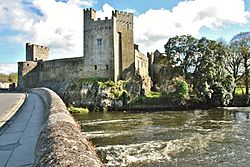Cahir Castle facts for kids
Quick facts for kids Cahir Castle
|
|
|---|---|
| County Tipperary Near Cahir in Ireland |
|
 |
|
|
Location in Ireland
|
|
| Coordinates | 52°22′28″N 7°55′38″W / 52.3745°N 7.9272°W |
| Type | Castle |
| Site information | |
| Owner | Office of Public Works |
| Open to the public |
Yes |
| Condition | Standing |
| Site history | |
| Built | 13th Century |
| Built by | O'Briens |
| In use | 13th Century-1800s |
| Fate | Preserved |
| Battles/wars | Cromwellian Conquest of Ireland |
| Official name | Cahir Castle |
| Reference no. | 507 |
Cahir Castle (Irish: Caisleán na Cathrach) is one of the biggest and best-preserved castles in Ireland. It stands proudly on an island in the River Suir. This amazing fortress was started way back in 1142 by Conchobar Ua Briain, who was a king of the area called Thomond.
Today, Cahir Castle is in the middle of Cahir town in County Tipperary. It's a very popular place to visit. You can take a guided tour or watch special video shows that tell you all about its history.
Contents
Cahir Castle: A Mighty Irish Fortress
How Cahir Castle Was Built
Early Beginnings
Cahir Castle was built on the site of an even older stone fort. This old fort was called a cathair, which is where the town of Cahir gets its name. The castle was built to protect against the Normans, who were expanding their power from the south.
The main parts of the castle you see today were built in the 13th century. The O'Brien family started this work. The castle was built in two main sections. The part closest to the street was built about 200 years before the section where the audio-visual show is now.
Later Changes and Repairs
In the late 1300s, the castle was given to the powerful Butler family. They made the castle much bigger and changed its design between the 15th and 17th centuries.
Over time, the castle started to fall apart in the late 1700s. But in the 1840s, some parts were fixed up. For example, the Great Hall was partly rebuilt around 1840.
A Look Back: Cahir Castle's Story
Early Owners and Challenges
In 1375, James Butler was given Cahir Castle. He was made an Earl by King Edward III of England because he was very loyal. James Butler's son later passed on the lands around the castle to his own children.
By 1542, a new title was created: the Baron of Cahir. This branch of the Butler dynasty was different from their relatives. They supported the Catholic Irish during the Elizabethan wars.
In 1599, the castle faced a big challenge. The army of the Earl of Essex attacked it. After a three-day siege, the castle was captured. For a year, it was looked after by Sir Charles Blount. Later, Lord Cahir joined forces with the Earl of Tyrone and was accused of treason. However, he was later forgiven.
Changing Hands: Wars and Sieges
Cahir Castle was attacked two more times during the Irish Confederate Wars. In 1647, the castle's guardian, George Mathew, gave up the castle to Murrough O'Brien. O'Brien was a descendant of the castle's original builder.
Then, in 1650, the castle surrendered again. This time, it was to Oliver Cromwell during his conquest of Ireland. Amazingly, not a single shot was fired during this surrender.
In 1961, the last Lord Cahir passed away. After this, Cahir Castle became the property of the Irish state.
Protecting a National Treasure
In the late 20th century, Cahir Castle was officially named a National Monument. This means it's a very important historical site that needs to be protected. Today, the Office of Public Works manages the castle. They keep it in good condition and offer tours to visitors.
Cahir Castle on Screen
Cahir Castle's impressive looks have made it a popular spot for filming movies and TV shows!
- In 1973, parts of the TV film The Conflict were filmed inside the castle.
- In 1981, it was used for a battle scene in the movie Excalibur.
- In 1998, the castle was a location for Saban's Mystic Knights Of Tir Na Nog show on Fox Kids.
- The castle was also used for the TV series The Tudors.
- More recently, in 2019, it was a location for the film The Green Knight.
- In 2020, it was used for the film The Last Duel.
Gallery
-
Walls and demesne
See also
 In Spanish: Castillo de Cahir para niños
In Spanish: Castillo de Cahir para niños







